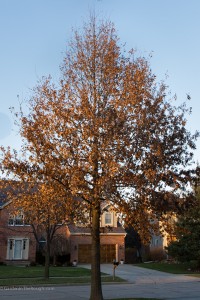Trees may be grouped into two types based on the duration of time with leaves: evergreen and deciduous. Evergreen trees have leaves or needles year round and the leaves or needles stay green (due to the presence of chlorophyll). Deciduous trees, on the other hand, have leaves for only part of the year and the leaves may change color (due to the disappearance of chlorophyll).
Interestingly, some deciduous trees like the pin oak tree pictured above have leaves that change color but the leaves do not drop until spring (this photo was taken in late November). This characteristic is referred to as marcescence, from the Latin marcescent – beginning to wither. Botanically speaking, the term refers to leaves or fronds that wither but remain attached to the stem.1 Beech, sycamore, and several species of oak have marcescent leaves.
What causes leaves to fall from trees? The leaves of deciduous trees have an abscission zone or abscission layer that forms where the leaf meets the stem. In response to changes in the length of the dark period each day, the cells in the abscission layer start to block the transport of nutrients between the leaf and the stem. Eventually, the cells weaken or are digested and the leaf separates from the tree. In marcescent leaves, the abscission zone is not present or does not fully develop until the start of the next growing season, when buds begin to emerge. The result is a deciduous tree that keeps its brown leaves all winter! The articles by Andrew Hipp2 and Ted Griess3 provide good overviews of this process. The US National Arboretum also has a nice summary.4
Not sure what type of tree you have? Try the searchable factsheets at the Department of Forest Resources and Environmental Conservation at Virginia Tech.
- Oxford Dictionaries. http://www.oxforddictionaries.com/definition/american_english/marcescent
- Hipp A. When oak leaves fail to fall. Tag Along. Vol 6 #2. Spring 2007. Available at: http://systematics.mortonarb.org/lab/publications/Hipp2007_TagAlong6_marcescence.pdf
- Griess T. Yard and Garden. 11-02-2013. Available at: http://buffalo.unl.edu/c/document_library/get_file?uuid=9419c5cc-3be5-45da-a972-f36d2022d071&groupId=134881&.pdf
- The Science of Color in Autumn Leaves. http://www.usna.usda.gov/PhotoGallery/FallFoliage/ScienceFallColor.html (accessed 11 December 2013)

